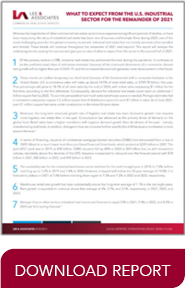What to Expect from the U.S. Industrial Sector for the Remainder of 2021
 Whereas the trajectories of other commercial real estate sectors have experienced significant periods of decline, or have been topsy turvy, the story of industrial real estate has been one of success and triumph. Even during 2020, one of the most challenging years for the global economy on record, industrial real estate has not merely survived, it has excelled and thrived. These trends will continue throughout the remainder of 2021 and beyond. This report will analyze the underlying trends causing the success and give you an idea of what to expect from the sector in the second half of 2021.
Whereas the trajectories of other commercial real estate sectors have experienced significant periods of decline, or have been topsy turvy, the story of industrial real estate has been one of success and triumph. Even during 2020, one of the most challenging years for the global economy on record, industrial real estate has not merely survived, it has excelled and thrived. These trends will continue throughout the remainder of 2021 and beyond. This report will analyze the underlying trends causing the success and give you an idea of what to expect from the sector in the second half of 2021.
1 Of the primary sectors in CRE, industrial real estate has performed the best during the pandemic. It continues to be the preferred asset class of real estate investors1 because of the continued dominance of e-commerce. Annual rent growth will be higher than pre-COVID-19, and this increased demand will generate more development in the future.
2 These trends are neither temporary nor short-lived because of the fundamental shift in consumer behavior in the United States. U.S. e-commerce sales will make up about 14.5% of total retail sales, or $709.78 billion, this year. That percentage will grow to 18.1% of all retail sales by the end of 2024, with online sales surpassing $1 trillion for the first time, according to the firm eMarketer. Consequently, demand for industrial real estate could reach an additional 1 billion square feet by 2025. To put into perspective how much extra warehouse space is needed, Prologis estimates that e-commerce companies require 1.2 million square feet of distribution space for each $1 billion in sales. As of June 2021, over 21 million square feet were under construction in the Inland Empire alone.
3 Moreover, the long-term structural growth rate of logistics real estate has risen. Economic growth now requires more logistics real estate than in the past. Consumption has advanced as the primary driver of demand on the global level. Retail sales have a higher correlation with logistics demand growth than do drivers of the past – namely, manufacturing and trade. In addition, changes in how we consume further amplify this shift because e-commerce is more space-intensive.2
4 In terms of financing, issuance of commercial mortgage-backed securities (CMBS) had rebounded from a low in 2009. Albeit to a much lower level than pre-Great Financial Crisis levels, which peaked at $229 billion in 2007. The post-GFC3 peak was in 2019, at $98 billion. CMBS issuance fell by 40% in 2020 to $59 billion but, as with transaction volume, decidedly above the declines of the GFC. Issuance is expected to rebound over the forecast period with $70 billion in 2021, $85 billion in 2022, and $90 billion in 2023.
5 The availability rate for the industrial/warehouse sector declined for the ninth straight year in 2018, to 7.0%, before notching up to 7.2% in 2019 and 7.4% in 2020. However, it stayed well below the 20-year average of 10.4%. It is forecast to plateau in 2021 at 7.4% before notching down again to 7.3% and 7.2% in 2022 and 2023, respectively.
6 Warehouse rental rate growth has been substantially above the long-term average of 1.1% in the last eight years. Rent growth is expected to continue above that average at 4%, 3.7%, and 3.1%, respectively, in 2021, 2022, and 2023.
7 Stronger than in other sectors, Industrial total returns are forecast to equal 12% in 2021, 9.3% in 2022, and 8.3% in 2023 per ULI’s spring forecast.4
Sources and Footnotes:
1 The only other asset classes to rival Industrial for investment funds were Data Centers and Life Science.
2 Prologis Report: https://bit.ly/2Th76p6
3 Great Financial Crisis
4 ULI Spring Forecast https://bit.ly/3c3ADJo
